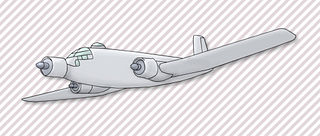 W
WThe DFS 230 was a German transport glider operated by the Luftwaffe in World War II. It was developed in 1933 by the Deutsche Forschungsanstalt für Segelflug with Hans Jacobs as the head designer. The glider was the German inspiration for the British Hotspur glider and was intended for airborne assault operations.
 W
WThe DFS 331 was a transport glider prototype developed in a collaboration between DFS and Gotha. It was a twenty-seat troop transport designed by Hans Jacobs, who had previously produced the successful, nine seat DFS 230.
 W
WThe Fieseler Fi 333 was a prototype transport aircraft developed by Fieseler in 1942, and backed by the Luftwaffe.
 W
WThe Heinkel He 111 was a German bomber aircraft designed by Siegfried and Walter Günter at Heinkel Flugzeugwerke in 1934. Through development it was described as a "wolf in sheep's clothing". Due to restrictions placed on Germany after the First World War prohibiting bombers, it masqueraded as a civil airliner, although from conception the design was intended to provide the nascent Luftwaffe with a fast medium bomber.
 W
WThe Heinkel He 111 was a German bomber aircraft designed by Siegfried and Walter Günter at Heinkel Flugzeugwerke in 1934. Through development it was described as a "wolf in sheep's clothing". Due to restrictions placed on Germany after the First World War prohibiting bombers, it masqueraded as a civil airliner, although from conception the design was intended to provide the nascent Luftwaffe with a fast medium bomber.
 W
WThe Junkers G.38 was a large German four-engined transport aircraft which first flew in 1929. Two examples were constructed in Germany. Both aircraft flew as a commercial transport within Europe in the years leading up to World War II.
 W
WThe Junkers Ju 52/3m is a transport aircraft that was designed and manufactured by German aviation company Junkers.
 W
WThe Junkers Ju 90 was a 40-seat, four-engine airliner developed for and used by Deutsche Luft Hansa shortly before World War II. It was based on the rejected Ju 89 bomber. During the war, the Luftwaffe impressed them as military transports.
 W
WThe Junkers Ju 252 was a German cargo aircraft that made its first flight in late October 1941. The aircraft was planned as a replacement for the Junkers Ju 52/3m in commercial airline service, but only a small number were built as cargo aircraft for the Luftwaffe.
 W
WThe Junkers Ju 290 was a large German, four-engine long-range transport, maritime patrol aircraft and heavy bomber used by the Luftwaffe late in World War II that had been developed from an earlier airliner.
 W
WThe Junkers Ju 322 Mammut was a heavy transport military glider, resembling a giant flying wing, proposed for use by the Luftwaffe in World War II; only two prototypes were completed, a further 98 were scrapped before completion.
 W
WThe Junkers Ju 352 Herkules was a German World War II transport aircraft that was developed from the Junkers Ju 252.
 W
WThe Junkers Ju 390 was a German long-range derivative of the Junkers Ju 290 aircraft, intended to be used as a heavy transport aircraft, maritime patrol aircraft and long-range bomber. It was one of the aircraft designs submitted for the abortive Amerika Bomber project, along with the Messerschmitt Me 264, the Focke-Wulf Ta 400 and the Heinkel He 277.
 W
WThe Messerschmitt Me 321 Gigant was a large German cargo glider developed and used during World War II. Intended to support large scale invasions, the Me 321 saw very limited use due to the low availability of suitable tug aircraft, high vulnerability whilst in flight and the difficult ground handling, both at base and at destination landing sites. The Me 321 was developed, in stages, into the six-engined Messerschmitt Me 323 Gigant, which removed some of the problems with ground handling, but vulnerability to ground fire and aerial attack remained a constant problem during operations of all variants.
 W
WThe Messerschmitt Me 323 Gigant ("Giant") was a German military transport aircraft of World War II. It was a powered variant of the Me 321 military glider and was the largest land-based transport aircraft to fly during the war. A total of 213 are recorded as having been made, 15 being converted from the Me 321.
 W
WThe Siebel Fh 104 Hallore was a small German twin-engined transport, communications and liaison aircraft built by Siebel.